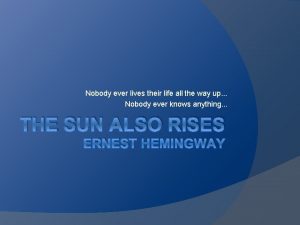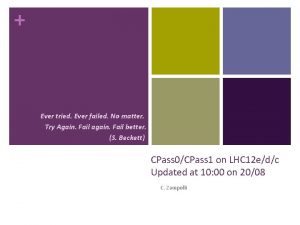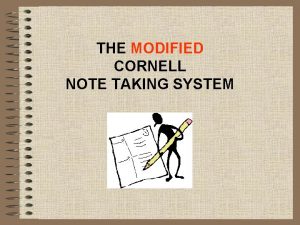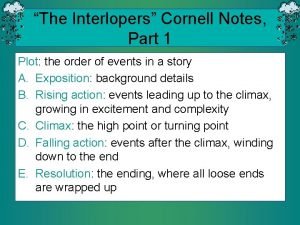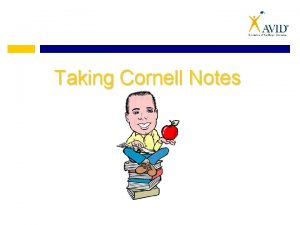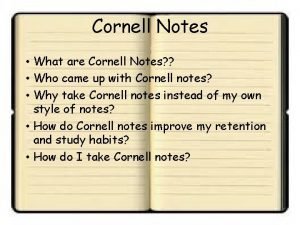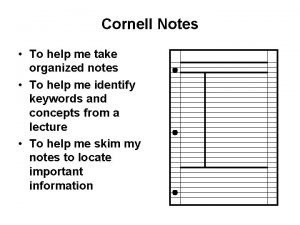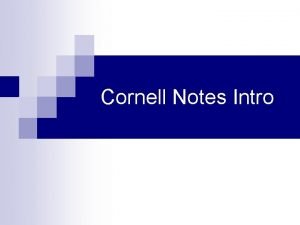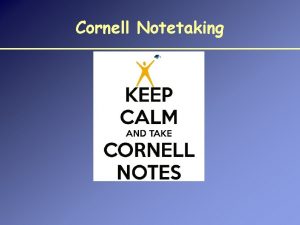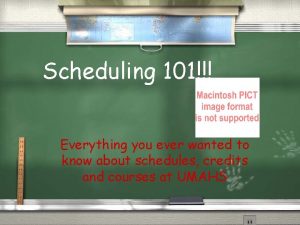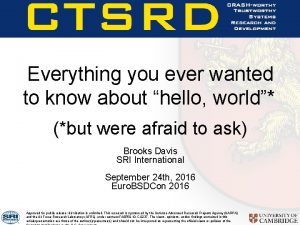CORNELL NOTES 101 Everything you ever wanted to










- Slides: 10

CORNELL NOTES 101 Everything you ever wanted to know about Cornell-style notes but were too afraid/disinterested/apathetic to ask!

2 1/2” Essential Questions Column After the lecture, create a question on this side for each of the main sections, topics, and/or ideas on the record side. Topic Title 6” First & Last Name Class Title Period Date Record Column • Record patterns of main idea and support • Chunk each section by concept • Put it in your own words • Strive to get main ideas down • Facts, details, examples (support) are important, but only meaningful when connected to concepts • Use indentations • Differentiates between main ideas and supporting ideas • Establishes a relationship between main ideas and supporting ideas • Supporting ideas are secondary 3 to 4 sentence summary across the bottom of the last page of the lecture notes. The easiest way to write the summary is to answer each of the questions in the left hand column of your notes.

Lets Practice! Using the same sheet of paper you used to set-up your Cornell notes template, you will now follow the format and take notes on the remainder of the Power. Point. Don’t be afraid to ask questions as we go, and if we’re moving too fast, please let me know!

History of Cornell Notes • Developed in 1949 at Cornell University by Walter Pauk. • Designed in response to frustration over poor student test scores. • Meant to be easily used as a test study guide. • Adopted by most major law schools as the preferred note-taking method.

Advantages • There are three main advantages to taking Cornell style notes 1. It is a method for mastering information, not just recording facts 2. It is efficient; chunks information in an organized way and streamlines study time 3. Each step prepares the way for the next part of the learning process

The Record Column Write main ideas and supporting material in the right column • Learn to use signals from the lecture – Titles & keywords= topics and main ideas – “Transition” words/phrases introduce patterns of support and/or details • First, most, some, this is called, there are two types Use abbreviations to get the full idea • Abbrev. will lead to less writing & more listening – more listening leads to better comprehension Leave spaces between ideas so you can • Fill in more later in case you learn new info or missed info • Move on if you’re lost and come back to it after asking questions • See how ideas relate to one another

The Question Column Write a question for each new • Topic • Main Idea • Concept • Significant Detail “Essential questions” • The answer to your essential question should be in one section on the right hand side – i. e. , if the notes on the right hand side pertain to the three different types of irony (verbal, situational, and dramatic) and their definitions, then the essential question on the left hand side might be “What are three different types of Irony? ” or “What are the definitions of the three different types of irony? ”

The Summary Write a summary at the end of your lecture notes • Should give you a snapshot of the main topic and the most important details • NOT a place to rewrite all of your notes; SUMMARIZE – Best method: Go down your list of questions on the left hand side and answer them one by one in 1 -2 sentences. • Don’t get fancy! Use the K. I. S. S. method… – Keep It Simple Stupid

How to Use your Notes Refine them! • • • Develop a code system of note-marking to indicate * If you’re a visual person, feel – Questions free to include images, – Main Ideas drawings, or icons to associate with your main ideas! – Important Points Mark unfamiliar vocabulary and unclear ideas in unique ways – Highlight all vocabulary in one color – Circle concepts you don’t fully understand Make sure you understand what you’ve written and make any corrections if you have to – The more you manipulate your notes, the better you will retain the information! Quiz yourself! • • • Cover up the right side of the page and read the questions. Recite information as fully as possible without looking at your notes. Uncover the sheet and verify that you’re getting the answers right frequently. – Statistics show that this is the single, most powerful learning tool

The Seven Step Process In this note-taking system you: 1. Record legibly and concisely on the right side 2. Refine lectures by underlining main ideas, starring important information, circling concepts you don’t understand fully 3. Reduce notes down to just the main ideas and create questions on the left 4. Recite by covering the right side and answering the questions on the left 5. Reflect on the notes by studying and drawing conclusions about how your notes fit the overall frame of reference for the unit of study 6. Recap by reviewing all notes and questions and recap the main ideas in the summary section 7. Review the notes, questions, and summary using the recite method; experts suggest 10 minutes a day
